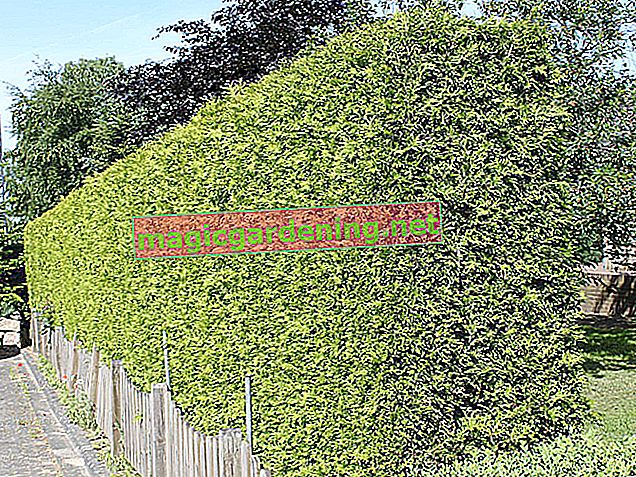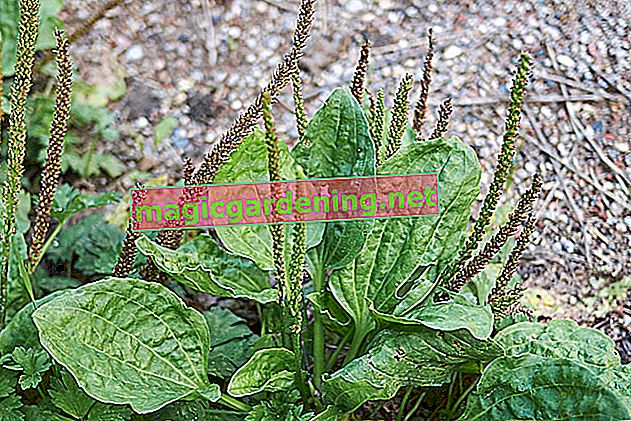
Tip 1: mow the lawn regularly
Periodic lawn mowing creates the basis for a dreamlike, dense grass area. The more regularly mowed, the better the stalks get used to the ideal cutting line. This results in a robust scar density with a beneficial effect on photosynthesis capacity. Such a lawn can easily cope with stressful situations of all kinds. How often is ideally mowed depends on the type of lawn, seed mix and location. The following information serves as a guide:
- Cut high-quality ornamental lawn every 7 days on average
- Fast growing cheap mixes twice a week during the summer
- Very slowly growing shadow lawn every 10-12 days
also read
- A lawn without mowing - create a lawn substitute or a wild meadow
- Simply leave the lawn behind after mowing
- Mowing the lawn in rainy weather - this is how you mow wet lawns
Tip 2: set the perfect cutting height
Hand in hand with the question of 'how often is it mowed' goes the topic of the optimal cutting height. The 'one-thirds rule' has proven itself as a reminder. Then a maximum of a third of the grass height should be mowed. The type of lawn and the prevailing weather dictate the ideal height. The following table serves as a guide for the most common types of lawn:
| The right cutting height according to the season | Ornamental lawn | Sports and play lawn | Shadow lawn |
|---|---|---|---|
| first cut in the year | 80 mm | 80 mm | 100 mm |
| normal weather | 35-45 mm | 30-40 mm | 70-80 mm |
| in drought | 50-60 mm | 45-50 mm | 100-150 mm |
| with permanent wetness | 40-50 mm | 35-45 mm | 85-95 mm |
| last cut in the year | 35-45 mm | 30-40 mm | 90 mm |
| absolute minimum amount | 20-25 mm | 30-35 mm | 60-70 mm |
If you follow the said 'one-third rule' when mowing the lawn, you will mow to an ideal height of 40 mm as soon as the stalks have grown to 60 mm.
Tips
You do not have to measure the individual blades of grass to determine the actual cutting height of your lawnmower. This is much less complicated: Simply place the mower on a level surface and use the tape measure or folding rule to determine the distance between the blades and the ground.
Tip 3: Never cut in wet weather
When it rains, the lawnmower should remain in the tool shed. If a lawn is mowed when it is soaked, a clean cut will not be achieved. In addition, the clippings clump together and the lawnmower is excessively strained. On top of that, the wheels of a heavy motorized lawnmower sink into the wet ground and damage the grass roots.
Tip 4: Always mow with sharp blades and high speed
German hobby gardeners still favor the motor-driven rotary mower for mowing the lawn. So that the rotating knives conjure up a harmonious cut, they should be as sharp as possible. If the cut surfaces are very frayed, the knives belong in the specialist workshop for regrinding. The winter break should also be used regularly to sharpen the cutting unit.
The speed of the lawnmower motor also has a decisive influence on the cutting pattern. If the cutter bar rotates at a speed of 3,000 revolutions per minute, you get a lawn like peeled from an egg.
Tip 5: Don't leave clippings lying around
If you do not use a collecting basket when mowing the lawn, the clippings will then be spread over the entire area. While mulching is one of the fundamental maintenance tasks in the kitchen and ornamental garden, this fact has a counterproductive effect on the lawn. Fungal spores and other pathogens find ideal living conditions under the clippings from which they can spread explosively.
It is therefore mandatory to sweep up the leftovers with a rake and dispose of them after each cutting. However, this premise does not apply when cutting the lawn with a mulching mower. This shreds the clippings into tiny pieces that act as natural fertilizer.
Mistake 1: cutting the lawn too early
When winter draws to a close, the lawn is reminiscent of an outgrown haircut. Understandably, ambitious hobby gardeners can hardly wait to cut the lawn for the first time. If you start too early now, you are doing your green business card a disservice. These characteristics show you the ideal time to cut the first lawn of the season:
- The stalks have reached a height of 80 to 100 millimeters
- No longer periods of frost are to be expected
- The nighttime temperatures no longer drop below 5 degrees
If you want to know exactly, add all temperatures above 0 degrees Celsius from January. If the total is 180, the time is ripe for the first mowing of the lawn and then scarifying.
Mistake 2: Mow the lawn too short
Every year during the holiday season, the image of the yellow discolored lawn is rampant in German hobby gardens. The cause is too short a cut after returning from vacation. If the lawn is allowed to grow unhindered for a few weeks, the vegetation point shifts upwards. If the minimum height is now mowed in one pass, the lawn will go into shock. How to handle it right:
- First cut the lawn at the highest cutting level of the mower
- In a second stage, shorten the blades of grass according to the 'one-third rule'
- After a week, the mowing is done to the ideal cutting height
Mistake 3: mowing the lawn in the blazing sun
When warm summer temperatures and blazing sunlight come together, the time of day for mowing the lawn needs to be chosen carefully. If the lawn is mowed at lunchtime, the stalks will burn on the cut wounds within minutes. The result is a brownish-yellow lawn that is difficult to recover.
Ideally, cut the lawn in the cooler hours of the morning or evening. In order not to get into a clinch with the neighbors, the legally prescribed rest periods must of course be taken into account.
Mistake 4: Entering the unmowed area
Did you actually take all of the 5 best tips to heart and still an uneven cutting pattern emerges after mowing the lawn? In this case, a common mistake has crept in, which goes unnoticed in the zeal of lawn care. If the blades of grass are trodden down shortly before they are cut, they will not stand up in time. The lawnmower blades do not detect these areas, which results in a wavy surface.
Mistake 5: Mowing the lawn stopped ahead of time
As the gardening year draws to a close, one of the most common mistakes when mowing the lawn comes to light. Knowing that the lawn should go long enough into the cold season, it is no longer mowed far too early. How to do it right:
- As long as the weather permits, mowing is carried out in the established cycle
- The growth of the grass continues until the first frost
- After the first frosty night, the lawnmower is used for the last time
Ideally, you will have our small table at hand so that you can read up on the optimal cutting height for winter time. Incidentally, there is nothing to be said against using the lawnmower to remove the remaining leaves later in the year. As long as the blades of grass are not mown again at the same time, you can use an excellent working aid to replace the leaf blower.
Tips & Tricks
Do you know the difference between a rotary mower and a cylinder mower? The sickle mower most commonly used in Germany cuts off the tips of the grass with rotating blades. The cylinder mower, on the other hand, gently cuts the stalks with a rotating cylinder, like scissors. Incidentally, the home of the cylinder mower is England, the motherland of the perfect lawn.








